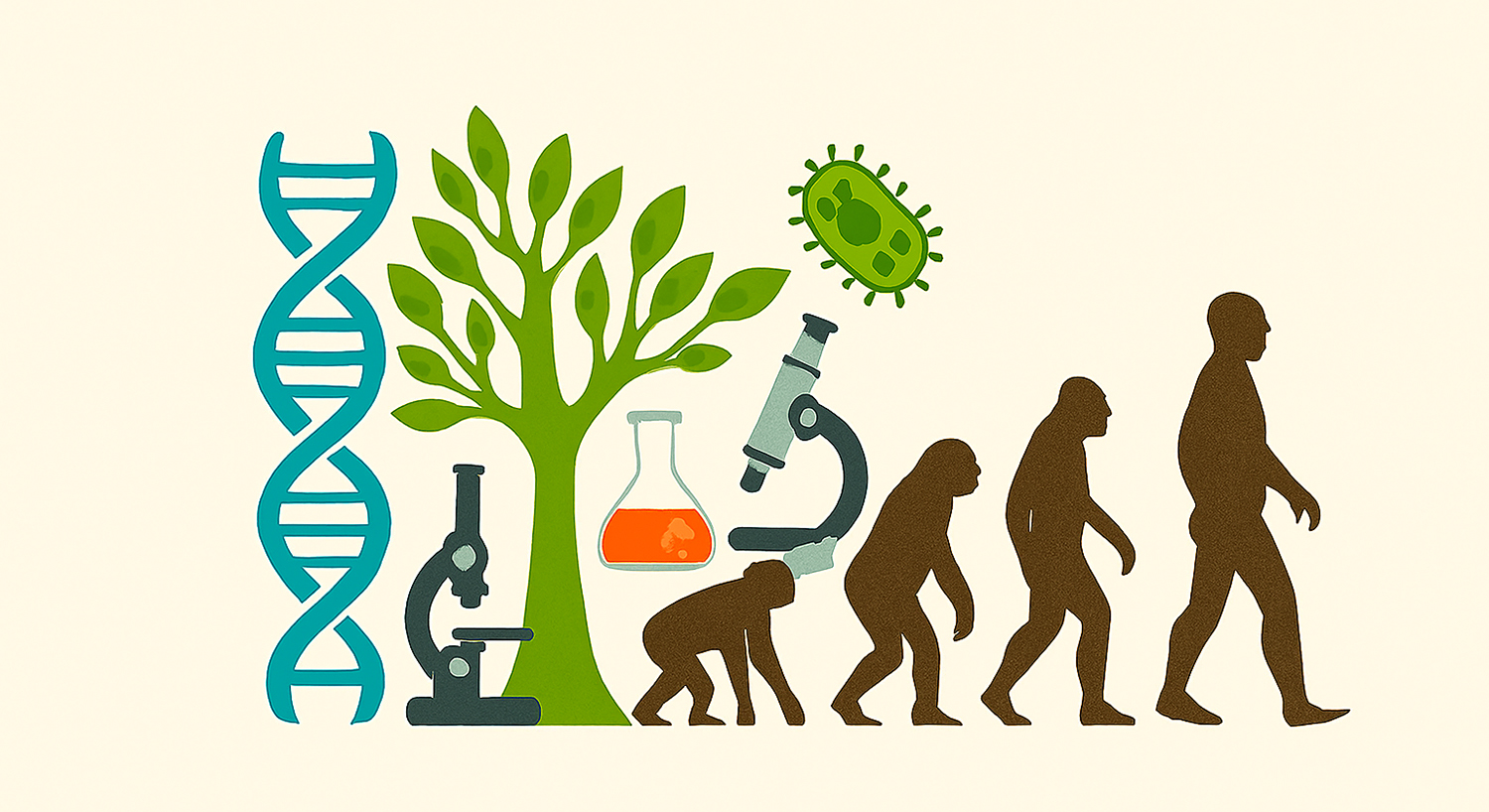
Biology and Evolution
Without viewing through the lens of evolution, nothing in biology makes any sense
Without considering evolution, nothing in biology makes sense.
Why are life-saving medicines first tested on mice during development?
Humans are also animals. The main difference between humans and other creatures lies in mathematical intelligence and cognitive awareness. Otherwise, body parts and structure are quite similar to other animals. Our DNA matches approximately 98.6% with chimpanzees, 97% with orangutans, and 85% with mice. This means that millions of years ago, mice, humans, chimpanzees, orangutans, bonobos, and monkeys shared a common ancestor. That’s why initial testing of medicines or treatments is done on mice or other evolutionarily close animals before being applied to humans. The reason behind these similarities is simple: all life forms on Earth originated from a common ancestor through millions of years of evolution. The more recently one species evolved from another, the more similarities they share.
If you observe closely, you’ll realize that without viewing life through the lens of evolution, much of today’s modern lifestyle and progress would be lost. Without evolutionary theory, we’d have to halt advancements in modern medicine, stop decoding DNA to treat complex diseases, abandon vaccine development, environmental balance studies, pollution control, global warming research, improved crop production, pesticide use—and thousands of other research efforts that would fill volumes. Evolutionary theory is so vital today that universities have even created new branches like evolutionary biology and evolutionary medicine.
Due to religious superstition, dogma, and dirty politics, this crucial scientific theory still lacks social acceptance. But regardless, it continues to impact your life. Thanks to evolution, we now have vaccines for pandemics like COVID-19, polio has been eradicated, smallpox is history, and improved crop varieties ensure full meals. With less effort, time, and cost, you get more yield—giving you rest and raising your standard of living. Whether you accept it or not, you benefit from it daily. Evolutionary evidence is visible all around us. Evolution is a proven science. Denying it means rejecting a major part of science.
Due to religious superstition, dogma, and dirty politics, this crucial scientific theory still lacks social acceptance. But regardless, it continues to impact your life. Thanks to evolution, we now have vaccines for pandemics like COVID-19, polio has been eradicated, smallpox is history, and improved crop varieties ensure full meals. With less effort, time, and cost, you get more yield—giving you rest and raising your standard of living. Whether you accept it or not, you benefit from it daily. Hundreds of pieces of evidence of evolution are visible before our eyes. Evolution is a fact—an ongoing process that is not up for debate. It is a scientifically proven and well-established theory that has stood the test of time. Denying it means rejecting a major part of science.
If humans came from monkeys, why aren’t monkeys turning into humans now? Why are there still so many monkeys?
People who ask this question aren’t seeking knowledge. They think their limited understanding can overturn the world. Most of their arguments fall under logical fallacies. They are simply ignorant. They fail to grasp the basic concept that humans, chimpanzees, orangutans, and bonobos all evolved from a common ancestor. Instead, they keep asking foolish questions like “If humans came from monkeys, why aren’t monkeys becoming humans now?”
Those who ask such questions understand nothing about evolution. Here’s a fresh example: COVID-19 began in China. It evolved into a new variant in South Africa, another in Brazil. Meanwhile, other countries had different variants. In India, it became Delta; in Bangladesh, it remained the Italian variant. Later, in parts of Africa, it evolved into Omicron, while India still had Delta. Evolution in organisms happens in response to their environment. Many variants emerge, but not all survive. COVID-19 has undergone thousands of mutations, but only strong variants like Delta and Omicron persist. Evolution doesn’t happen the same way everywhere. Major evolutionary changes take thousands or even millions of years. It’s not something visible within a human lifespan of 60–70 years, though there is abundant evidence supporting it.
The animal shown in the video is a bonobo. Their DNA matches 98.7% with humans.
Related Posts

Sunlight: A Natural Medicine, Cultural Wisdom, and the Key to Healthy Longevity
For thousands of years, many civilizations have worshipped the sun as a deity – notRead More

সূর্যের আলো: প্রাকৃতিক ঔষধ, সাংস্কৃতিক শিক্ষা ও স্বাস্থ্যকর দীর্ঘায়ুর চাবিকাঠি
হাজার হাজার বছর ধরে অনেক সভ্যতা সূর্যকে দেবতা মানে; শুধু বৈদিক, পৌরাণিক, এবং সাংস্কৃতিক ঐতিহ্য,Read More

Protecting women is a man’s responsibility – this is a lesson rooted in evolutionary psychology
A common tendency across all societies is to take extra care of women. This isRead More

Comments are Closed